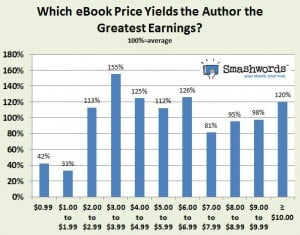As promised, here at BookPromotion.com we are constantly experimenting on our own work and reporting the results back to you. I like to think of this as “trying and failing/ succeeding so you don’t have to.”
As you probably know, Amazon (through their Kindle Direct/ KDP program) wants you to keep the pricing of your eBooks within the $2.99 – $9.99 zone. They do this by penalizing you (in terms of royalty percentage) when you go over or under this window. For instance, you make 70% royalty (in most countries) on a book in the $2.99 – $9.99 price range, but drop below or above this range, and you’ll only get a 35% royalty. Ouch! You don’t have to be able to do algebra in your head to figure out that you’re going to have to sell a huge amount of books at $.99/ apiece to make up for that lost percentage. So, while you might want to keep your book’s prices low to entice your customers, doing so might cost you (literally).
Here are some thoughts on the low/ high ends of the book pricing argument:
— Free: Amazon will let you do this for five out of every ninety days if you’re enrolled in their KDP Select program. Our suggestion is that you use these five free days to get as many downloads and reviews as possible. This can be a good strategy for authors trying to build their mailing lists (of course, you’d need a link for email signup in the front or back matter of the book), and can get you some sales in the “post free” lift period that occurs immediately after your book is free. We have been noticing lately that Amazon is cracking down on this “lift” period, however, so don’t count on this being a huge number.
— $0.99 – $1.99: With pricing in this zone, you’re only getting the 35% royalty, so you need to make sure you’re doing a larger volume of copies at these prices. It is true that some books will only sell at this price, and at that point, you should be trying your best to get the reader to perform a secondary action (like signing up for your mailing list or buying another book). Amazon does not want you to use this pricing model, so make sure it is worth your while if you have to take that pay cut.
— $2.99 – $9.99: This is Amazon’s “sweet spot” for self publishers, and if you stay within it, they will reward you with a 70% royalty. That is awesome, especially if your market research shows that your book can sustain this pricing.
Over $9.99: This is not pricing I would recommend for self publishers (in fact, I even advise large publishers against this, and some of them are starting to listen to me). Amazon’s user base of readers gets savvier every day; if your Kindle book is priced at $19.99, this not only makes you look like you don’t know the eBook market and are clinging on to legacy hardcover pricing, you also are almost daring someone to buy the book at that price and then leave it a scathing one-star review over quality/ pricing. I have seen this happen more than once, so please consider this a warning. Also, remember that big publishers have totally different deals with retailers, so you don’t know what they are getting paid on a book priced at $14.99 for the eBook version.
Here is some excellent wisdom on pricing experimentation from author Dave Hendricks:
I start each new book at 99¢. After I’ve gotten at least 10 reviews I raise the price to $2.99 to get 70% royalties. After that, I raise the price by $1 every 2-4 weeks. The longer testing period is necessary if my sales fluctuate a lot. When the weekly royalties stop rising, I stop raising the prices. Or I stop at $9.87, whichever comes first. Do not judge your price point by the NUMBER of sales, but by the profit you make.
Finally, I will show you this chart (that Dave also told me about), from Smashwords:

Here’s what Dave concluded from the chart: SmashWords did research that revealed that, in general, price points between $3 and $3.99 were the most profitable for most authors. Prices between $6 and $6.99 were the second most profitable, followed closely by price points between $4 and $4.99. But that’s a generalization. Every book and topic is different, so experiment to find out your own most profitable price point.
The bottom line: you should be conducting market research on your book / topic/ genre regularly to see what the market will tolerate in terms of pricing your particular book. If you want to read more about Amazon’s pricing, here is a link.
And with that, I will leave you to consider the all-important question: should I try changing my book’s price today?
